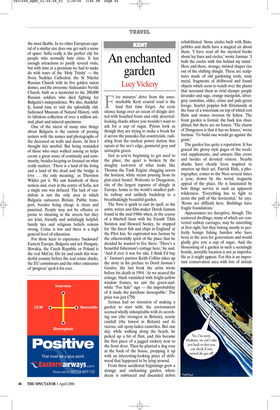An enchanted garden
Lucy Vickery
Five minutes’ drive from the unremarkable Kent coastal road is the land that time forgot. An eerie silence hangs over an ocean of shingle dotted with beached boats and odd, desertedlooking shacks where you wouldn’t want to ask for a cup of sugar. Pylons look as though they are trying to make a break for it across the pancake-flat countryside, radiating from the nuclear power station that squats at the sea’s edge, gunmetal grey and antiseptic green.
Just as you’re beginning to get used to the place, the quiet is broken by the doughty toot-toot of what looks like Thomas the Tank Engine chugging across the horizon, white steam pouring from its pint-sized funnel. Welcome to Dungeness, site of the largest expanse of shingle in Europe, home to the world’s smallest public railway and unlikely backdrop to a breathtakingly beautiful garden.
The Ness is quick to cast its spell, as the artist, writer and film-maker Derek Jarman found in the mid-1980s when, in the course of a bluebell hunt with his friends Tilda Swinton and Howard Sooley, he stopped for ‘the finest fish and chips in England’ at the Pilot Inn. So captivated was Jarman by the otherworldly spirit of the place that he decided he wanted to live there. ‘There’s a beautiful fisherman’s cottage here,’ he said. ‘And if ever it was for sale, I think I’d buy it.’ Jarman’s partner Keith Collins takes up the story in his preface to Derek Jarman’s Garden, the last book the artist wrote before his death in 1994. ‘As we neared the cottage, black varnished with bright-yellow window frames, we saw the green-andwhite “For Sale” sign — the improbability of it made the purchase inescapable.’ The price was just £750.
Jarman had no intention of making a garden to start with; the environment seemed wholly inhospitable with its scorching sun (the strongest in Britain), scanty rainfall (the lowest in Britain) and its vicious, salt spray-laden easterlies. But one day, while walking along the beach, he picked up a bit of flint, and this became the first piece of a jagged rockery next to the front door. Then he planted a dog rose at the back of the house, propping it up with an interesting-looking piece of driftwood that happened to be lying around.
From these accidental beginnings grew a strange and enchanting garden, where decay is embraced and discarded debris rehabilitated. Stone circles built with flints, pebbles and shells have a magical air about them. ‘I have read all the mystical books about ley lines and circles,’ wrote Jarman. ‘I built the circles with this behind my mind.’ Here and there, strange, twisted shapes rise out of the shifting shingle. These are sculptures made of old gardening tools, rusty metal, fragments of driftwood and found objects which seem to watch over the plants that surround them in vivid clumps: purple lavender and sage, orange marigolds, silvergrey santolina, elder, cistus and pale-green lovage. Scarlet poppies bob flirtatiously at the base of a watertank on top of which rest flints and stones overrun by lichen. The front garden is formal, the back less disciplined, but there are no fences. ‘The charm of Dungeness is that it has no fences,’ wrote Jarman. ‘To build one would go against the grain.’ The garden has quite a reputation. It has graced the glossy style pages of the weekend supplements, and attracts film crews and hordes of devoted visitors. Nearby shacks have clearly been inspired to smarten up their act. Patrick Hale, a photographer, comes to the Ness several times a year, drawn by the weird, magnetic appeal of the place. He is fascinated by how things survive in such an apparent wilderness. ‘Everything has to fight to resist the pull of the horizontal,’ he says. ‘Roots are difficult here. Buildings have fragile foundations.’ Appearances are deceptive, though. The scattered dwellings, many of which are converted railway carriages, may be unsettling at first sight, but they belong mostly to perfectly benign fishing families who have been in the area for generations and would gladly give you a cup of sugar. And the blossoming of a garden in such a seemingly hostile, unstable location is not as improbable as it might appear. For this is an important conservation area with lots of initials after its name — NNR (National Nature Reserve), SPA (Special Protection Area) and SAC (Special Area of Conservation ) — and its shingle ridges are home to a unique and diverse range of plant life (more than 600 species, compared with only 1,800 in the whole of Britain).
Sea kale thrives on the Ness as its roots are at least 20 feet long. It lies dormant in winter, then goes through several dramatic incarnations as the seasons come and go. It’s joined by bright-blue viper’s bugloss, pink and white valerian, and yellowhorned poppies. There are also many rare and important animals and insects; moths in particular like it here — the Sussex Emerald Moth, which feeds on wild carrots, is found only in Dungeness. Birdwatchers flock to the RSPB reserve to see the wheatears, the smews, the bitterns and the little ringed plovers. An area known as ‘the patch’ is where waste warm water is expelled from the nuclear power station’s outfall pipes and pumped into the sea. This creates ideal conditions for fish, and provides a fertile feeding ground for squadrons of ravenous gulls and terns.
Behind the facade of its post-apocalyptic landscape and the sinister shadow cast by the nuclear power stations, Dungeness is alive and kicking. It accommodates innocence and experience in the same way as Porton Down, Britain’s chemical and germ warfare establishment in Wiltshire, a restricted area for most of the 20th century and now home to a uniquely rich array of wildlife. Derek Jarman spent his final years giving life to his garden at Prospect Cottage. ‘The garden has been both Gethsemane and Eden,’ he wrote.



























































































 Previous page
Previous page